Benefits and Trade-Offs from Land Use and Land Cover Changes Under Different Scenarios in the Coastal Delta of Vietnam
Abstract
1. Introduction
2. Materials and Methods
2.1. Study Area
2.2. Data Used
2.2.1. Satellite Images and Preprocessing Procedures
2.2.2. Data on Driving Forces
2.3. Methods
2.3.1. LULC Map Classification
2.3.2. Simulation of Future LULC Using Cellular Automata–Markov Chain
2.3.3. Future Development Scenarios
2.3.4. Quantification of Economic Value and Ecosystem Services
3. Results
3.1. LULC Patterns and Changes from 2010 to 2020
3.2. Future LULC in 2030
3.2.1. Natural Growth (BAU)
3.2.2. Climate Change Challenges (CCC)
3.2.3. Profit Optimization (PO)
3.2.4. Adaptive Solutions (ADs)
3.3. Changes in Economic and Ecosystem Service Values
4. Discussion
4.1. Driving Forces of Coastal LULCC
4.2. Benefits and Trade-Offs from LULC Scenarios
4.3. Mainstreaming ESS in Land Use Planning
4.4. Research Limitations and Future Research
5. Conclusions
Author Contributions
Funding
Data Availability Statement
Acknowledgments
Conflicts of Interest
Appendix A
| Driving Forces | SRICE | DRICE | TRICE | ACRO | PLANT | AQUA | WAT | CONS | FOR | Total |
|---|---|---|---|---|---|---|---|---|---|---|
| Distance to coastline | 0.073 | 0.090 | 0.120 | 0.100 | 0.116 | 0.135 | 0.070 | 0.020 | 0.438 | 1.162 |
| Elevation | 0.098 | 0.090 | 0.090 | 0.074 | 0.113 | 0.126 | 0.240 | 0.060 | 0.080 | 0.971 |
| Distance to dikes | 0.080 | 0.070 | 0.050 | 0.048 | 0.080 | 0.070 | 0.050 | 0.030 | 0.020 | 0.498 |
| Distance to urban centers | 0.068 | 0.086 | 0.090 | 0.060 | 0.136 | 0.072 | 0.098 | 0.564 | 0.050 | 1.224 |
| Population | 0.097 | 0.067 | 0.070 | 0.067 | 0.072 | 0.104 | 0.079 | 0.056 | 0.042 | 0.653 |
| Precipitation | 0.067 | 0.167 | 0.129 | 0.100 | 0.110 | 0.136 | 0.086 | 0.060 | 0.016 | 0.871 |
| Distance to rivers | 0.095 | 0.061 | 0.046 | 0.076 | 0.060 | 0.073 | 0.048 | 0.048 | 0.010 | 0.516 |
| Distance to roads | 0.047 | 0.053 | 0.084 | 0.050 | 0.050 | 0.029 | 0.060 | 0.043 | 0.008 | 0.423 |
| Salinity | 0.010 | 0.055 | 0.030 | 0.130 | 0.015 | 0.007 | 0.018 | 0.004 | 0.020 | 0.289 |
| Slope | 0.129 | 0.100 | 0.090 | 0.070 | 0.134 | 0.100 | 0.097 | 0.050 | 0.219 | 0.988 |
| Soil type | 0.015 | 0.012 | 0.012 | 0.015 | 0.013 | 0.098 | 0.060 | 0.014 | 0.029 | 0.268 |
| Temperature | 0.218 | 0.142 | 0.170 | 0.200 | 0.085 | 0.130 | 0.090 | 0.029 | 0.050 | 1.114 |
| LULC | Current Area (ha) | Converted Area (ha) | Proportion of Converted Area (%) | ||||||||
|---|---|---|---|---|---|---|---|---|---|---|---|
| 2020 | BAU | CCC | PO | ADs-5% | ADs-10% | BAU | CCC | PO | ADs-5% | ADs-10% | |
| SRICE | 1659 | −1010 | −594 | −586 | 657 | 4444 | 3.8 | 0.7 | 1.1 | 1.0 | 4.2 |
| DRICE | 80,261 | 9995 | 25,786 | −3899 | 18,136 | 23,538 | 37.4 | 32.3 | 7.4 | 28.7 | 22.2 |
| TRICE | 43,464 | −9581 | −24,512 | −4570 | −17,440 | −28,309 | 35.8 | 30.7 | 8.6 | 27.6 | 26.7 |
| ACRO | 8713 | −2777 | −211 | −2319 | −400 | −2420 | 10.4 | 0.3 | 4.4 | 0.6 | 2.3 |
| PLANT | 126,913 | 1542 | −14,660 | −15,068 | 10,516 | 22,660 | 5.8 | 18.3 | 28.5 | 16.7 | 21.4 |
| AQUA | 34,159 | 1484 | 11,904 | 22,828 | −13,707 | −22,249 | 5.6 | 14.9 | 43.2 | 21.7 | 21.0 |
| WAT | 20,397 | 0 | 0 | 0 | 0 | 0 | 0 | 0 | 0 | 0 | 0 |
| CONS | 3652 | 347 | 2260 | 3615 | 2239 | 2335 | 1.3 | 2.8 | 6.8 | 3.5 | 2.2 |
| FOR | 8760 | 0 | 0 | 0 | 0 | 0 | 0 | 0 | 0 | 0 | 0 |
| Total absolute area change (ha) | 26,737 | 79,926 | 52,884 | 63,094 | 105,954 | ||||||
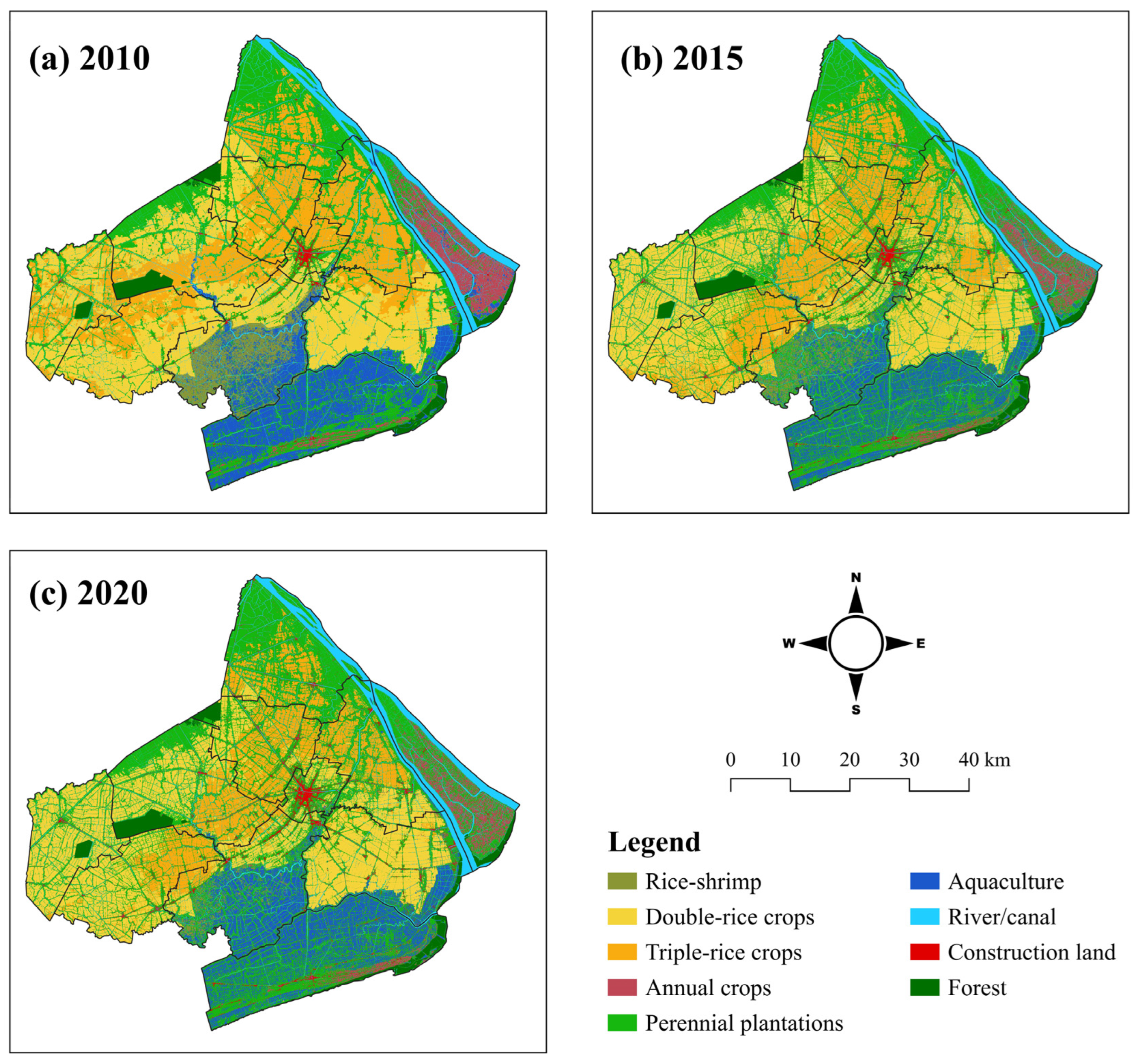
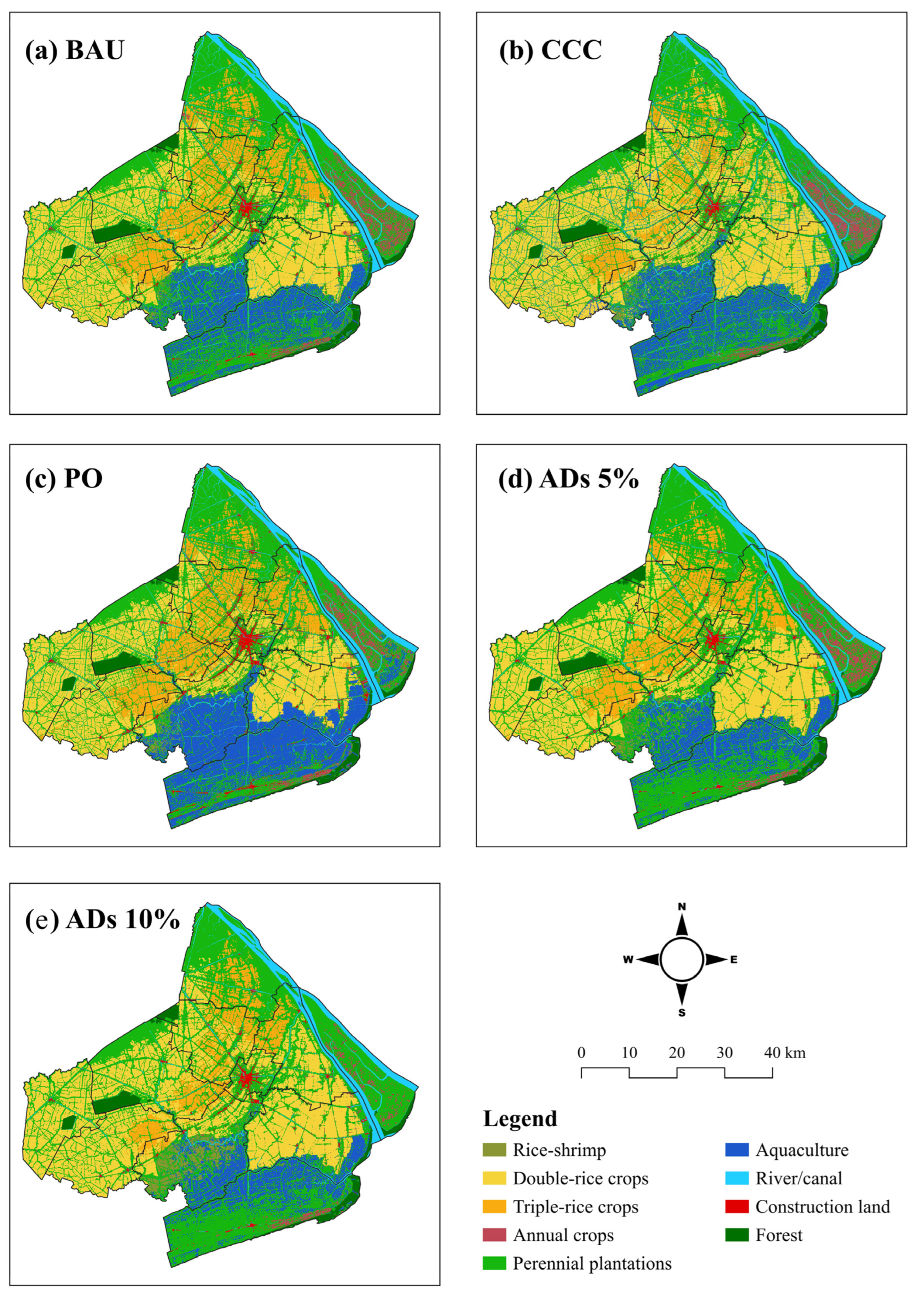
References
- Lau, J.D.; Hicks, C.C.; Gurney, G.G.; Cinner, J.E. What Matters to Whom and Why? Understanding the Importance of Coastal Ecosystem Services in Developing Coastal Communities. Ecosyst. Serv. 2019, 35, 219–230. [Google Scholar] [CrossRef]
- Le, H.M.; Ludwig, M. The Salinization of Agricultural Hubs: Impact of and Adjustment to Intensifying Saltwater Intrusion in the Mekong Delta. In Proceedings of the Beiträge zur Jahrestagung des Vereins für Socialpolitik 2022: Big Data in Economics, Basel, Switzerland, 11–14 September 2022; ZBW—Leibniz Information Centre for Economics: Kiel, Hamburg, 2022. [Google Scholar]
- Joffre, O.; Prein, M.; Tung, P.B.V.; Saha, S.B.; Hao, N.V.; Alam, M.J. Evolution of Shrimp Aquaculture Systems in the Coastal Zones of Bangladesh and Vietnam: A Comparison. In Tropical Deltas and Coastal Zones: Food Production, Communities and Environment at the Land and Water Interface; CABI: Wallingford, UK, 2010; pp. 48–63. [Google Scholar]
- Thanh, B.N.; Le Van Thuy, T.; Nguyen Anh, M.; Nguyen Nguyen, M.; Nguyen Hieu, T. Drivers of Agricultural Transformation in the Coastal Areas of the Vietnamese Mekong Delta. Environ. Sci. Policy 2021, 122, 49–58. [Google Scholar] [CrossRef]
- Mehvar, S.; Filatova, T.; Dastgheib, A.; Steveninck, E.D.R.V.; Ranasinghe, R. Quantifying Economic Value of Coastal Ecosystem Services: A Review. J. Mar. Sci. Eng. 2018, 6, 5. [Google Scholar] [CrossRef]
- Rao, N.S.; Ghermandi, A.; Portela, R.; Wang, X. Global Values of Coastal Ecosystem Services: A Spatial Economic Analysis of Shoreline Protection Values. Ecosyst. Serv. 2015, 11, 95–105. [Google Scholar] [CrossRef]
- Barbier, E.B.; Hacker, S.D.; Kennedy, C.; Koch, E.W.; Stier, A.C.; Silliman, B.R. The Value of Estuarine and Coastal Ecosystem Services. Ecol. Monogr. 2011, 81, 169–193. [Google Scholar] [CrossRef]
- Nguyen, C.T.; Downes, N.K.; Sitthi, A.; Losiri, C. Tourism-Induced Land Use Transformations, Urbanisation, and Habitat Degradation in the Phu Quoc Special Economic Zone. Urban Sci. 2025, 9, 11. [Google Scholar] [CrossRef]
- Neumann, B.; Ott, K.; Kenchington, R. Strong Sustainability in Coastal Areas: A Conceptual Interpretation of SDG 14. Sustain. Sci. 2017, 12, 1019–1035. [Google Scholar] [CrossRef]
- Hernández-Delgado, E.A. The Emerging Threats of Climate Change on Tropical Coastal Ecosystem Services, Public Health, Local Economies and Livelihood Sustainability of Small Islands: Cumulative Impacts and Synergies. Mar. Pollut. Bull. 2015, 101, 5–28. [Google Scholar] [CrossRef] [PubMed]
- Klein, R.J.T.; Nicholls, R.J. Assessment of Coastal Vulnerability to Climate Change. Ambio 1999, 28, 182–187. [Google Scholar]
- Diem, P.K.; Diem, N.K.; Nguyen, C.T.; Minh, V.Q. Impacts of Extreme Drought on Rice Planting Calendar in Vietnamese Mekong Delta. Paddy Water Environ. 2024, 22, 139–153. [Google Scholar] [CrossRef]
- Pham, T.D.; Nguyen, D.T.H.; Nguyen, C.T. Drought Assessment in Paddy Rice Fields Using Multi-Temporal SAR Data of Sentinel-1: A Case Study in Tra Vinh Province. In Applied Geography and Geoinformatics for Sustainable Development. Springer Geography; Boonpook, W., Lin, Z., Downes, N.K., Truong, Q.C., Eds.; Springer: Cham, Switzerland, 2025; pp. 97–113. [Google Scholar]
- Nguyen, C.T.; Kaewthongrach, R.; Channumsin, S.; Chongcheawchamnan, M.; Phan, T.N.; Niammuad, D. A Regional Assessment of Ecological Environment Quality in Thailand Special Economic Zone: Spatial Heterogeneous Influences and Future Prediction. Land Degrad. Dev. 2023, 34, 5770–5787. [Google Scholar] [CrossRef]
- Ferrol-Schulte, D.; Wolff, M.; Ferse, S.; Glaser, M. Sustainable Livelihoods Approach in Tropical Coastal and Marine Social-Ecological Systems: A Review. Mar. Policy 2013, 42, 253–258. [Google Scholar] [CrossRef]
- Landa, D.E.L.; Bueno, C.V.G. “Climate Change Might Have Caused Our Small Harvest”: Indigenous Vulnerability, Livelihoods, and Environmental Changes in Lowland and High Jungle Indigenous Communities in Peru. J. Environ. Stud. Sci. 2022, 12, 216–231. [Google Scholar] [CrossRef] [PubMed]
- Tran, D.D.; Dang, M.M.; Du Duong, B.; Sea, W.; Vo, T.T. Livelihood Vulnerability and Adaptability of Coastal Communities to Extreme Drought and Salinity Intrusion in the Vietnamese Mekong Delta. Int. J. Disaster Risk Reduct. 2021, 57, 102183. [Google Scholar] [CrossRef]
- Huq, N.; Hugé, J.; Boon, E.; Gain, A.K. Climate Change Impacts in Agricultural Communities in Rural Areas of Coastal Bangladesh: A Tale of Many Stories. Sustainability 2015, 7, 8438–8460. [Google Scholar] [CrossRef]
- Phuong, L.T.H.; Biesbroek, G.R.; Sen, L.T.H.; Wals, A.E.J. Understanding Smallholder Farmers’ Capacity to Respond to Climate Change in a Coastal Community in Central Vietnam. Clim. Dev. 2018, 10, 701–716. [Google Scholar] [CrossRef]
- Nguyen, P.C.; Vu, P.T.; Khuong, N.Q.; Minh, H.V.T.; Vo, H.A. Saltwater Intrusion and Agricultural Land Use Change in Nga Nam, Soc Trang, Vietnam. Resources 2024, 13, 18. [Google Scholar] [CrossRef]
- Nguyen, M.T.; Renaud, F.G.; Sebesvari, Z. Drivers of Change and Adaptation Pathways of Agricultural Systems Facing Increased Salinity Intrusion in Coastal Areas of the Mekong and Red River Deltas in Vietnam. Environ. Sci. Policy 2019, 92, 331–348. [Google Scholar] [CrossRef]
- Nghia, B.P.Q.; Pal, I.; Chollacoop, N.; Nguyen, L.H.; Van Thinh, L.; Tuan, T.M.; Van Tuong, N. Integrated Approach for Drought and Saline Intrusion Severity Assessment on the Coastal Mekong Delta of Vietnam Contextualizing Physical Change to Risk Management and Policy Development. Prog. Disaster Sci. 2024, 23, 100338. [Google Scholar] [CrossRef]
- Hong, H.T.C.; Avtar, R.; Fujii, M. Monitoring Changes in Land Use and Distribution of Mangroves in the Southeastern Part of the Mekong River Delta, Vietnam. Trop. Ecol. 2019, 60, 552–565. [Google Scholar] [CrossRef]
- Sakamoto, T.; Van Phung, C.; Kotera, A.; Nguyen, K.D.; Yokozawa, M. Analysis of Rapid Expansion of Inland Aquaculture and Triple Rice-Cropping Areas in a Coastal Area of the Vietnamese Mekong Delta Using MODIS Time-Series Imagery. Landsc. Urban Plan. 2009, 92, 34–46. [Google Scholar] [CrossRef]
- Kruse, J.; Koch, M.; Khoi, C.M.; Braun, G.; Sebesvari, Z.; Amelung, W. Land Use Change from Permanent Rice to Alternating Rice-Shrimp or Permanent Shrimp in the Coastal Mekong Delta, Vietnam: Changes in the Nutrient Status and Binding Forms. Sci. Total Environ. 2020, 703, 134758. [Google Scholar] [CrossRef] [PubMed]
- Tinh, P.H.; MacKenzie, R.A.; Hung, T.D.; Van Vinh, T.; Ha, H.T.; Lam, M.H.; Hanh, N.T.H.; Tung, N.X.; Hai, P.M.; Huyen, B.T. Mangrove Restoration in Vietnamese Mekong Delta during 2015–2020: Achievements and Challenges. Front. Mar. Sci. 2022, 9, 1043943. [Google Scholar] [CrossRef]
- Liu, S.; Li, X.; Chen, D.; Duan, Y.; Ji, H.; Zhang, L.; Chai, Q.; Hu, X. Understanding Land Use/Land Cover Dynamics and Impacts of Human Activities in the Mekong Delta over the Last 40 Years. Glob. Ecol. Conserv. 2020, 22, e00991. [Google Scholar] [CrossRef]
- Truong, Q.C.; Gaudou, B.; Van Danh, M.; Quang Huynh, N.; Drogoul, A.; Taillandier, P. A Land-Use Change Model to Study Climate Change Adaptation Strategies in the Mekong Delta. In Proceedings of the 2021 RIVF International Conference on Computing and Communication Technologies (RIVF), Hanoi, Vietnam, 19–21 August 2021; pp. 1–6. [Google Scholar] [CrossRef]
- Truong, Q.C.; Nguyen, T.H.; Pham, V.T.; Nguyen, T.H. Land-Use Optimization and Allocation for Saltwater Intrusion Regions: A Case Study in Soc Trang Province, Vietnam. Climate 2024, 12, 16. [Google Scholar] [CrossRef]
- Diep, N.T.H.; Can, N.T.; Diem, P.K.; My, T. Le Spatial Analysis for the Effects of Land-Use Changes Cause of Salinity Intrusion in Soc Trang Province. Can Tho Univ. J. Sci. 2019, 55, 1–7. [Google Scholar] [CrossRef]
- Tri, L.Q.; Guong, V.T.; Vu, P.T.; Binh, N.T.S.; Kiet, N.H.; Chien, V. Van Evaluating the Changes of Soil Properties and Land Use at Three Coastal Districts in Soc Trang Province. Can Tho Univ. J. Sci. 2008, 9, 59–68. [Google Scholar]
- Han, H.; Yang, C.; Song, J. Scenario Simulation and the Prediction of Land Use and Land Cover Change in Beijing, China. Sustainability 2015, 7, 4260–4279. [Google Scholar] [CrossRef]
- Xiong, N.; Yu, R.; Yan, F.; Wang, J.; Feng, Z. Land Use and Land Cover Changes and Prediction Based on Multi-Scenario Simulation: A Case Study of Qishan County, China. Remote Sens. 2022, 14, 4041. [Google Scholar] [CrossRef]
- Loukika, K.N.; Keesara, V.R.; Buri, E.S.; Sridhar, V. Future Prediction of Scenario Based Land Use Land Cover (LU&LC) Using DynaCLUE Model for a River Basin. Ecol. Inform. 2023, 77, 102223. [Google Scholar] [CrossRef]
- Liu, X.; Liang, X.; Li, X.; Xu, X.; Ou, J.; Chen, Y.; Li, S.; Wang, S.; Pei, F. A Future Land Use Simulation Model (FLUS) for Simulating Multiple Land Use Scenarios by Coupling Human and Natural Effects. Landsc. Urban Plan. 2017, 168, 94–116. [Google Scholar] [CrossRef]
- Athukorala, D.; Murayama, Y.; Bandara, C.M.M.; Lokupitiya, E.; Hewawasam, T.; Gunatilake, J.; Karunaratne, S. Effects of Urban Land Change on Ecosystem Service Values in the Bolgoda Wetland, Sri Lanka. Sustain. Cities Soc. 2024, 101, 105050. [Google Scholar] [CrossRef]
- Nguyen, C.T.; Ton-That, L.; Pham, T.D. Land Use, Land Cover Changes and Expansion of Artificial Reservoirs in Eastern Thailand: Implications for Agriculture and Vegetation Drought Reduction. Environ. Monit. Assess. 2024, 196, 1009. [Google Scholar] [CrossRef] [PubMed]
- Ngoc, D.M.; Nu, N.T.; Toan, D.M.; Son, B.T. Study on Soft Ground Structure in the Mekong Delta Coastal Province, Viet Nam for Embankment Construction. J. Appl. Sci. Eng. 2021, 24, 307–314. [Google Scholar]
- Soc Trang Provincial Party Committee. Soc Trang agricultural imprint in 2024. Available online: https://soctrang.dcs.vn/Default.aspx?sname=tinhuy&sid=4&pageid=469&catid=54386&id=301439&catname=Kinh+t%u1ebf&title=dau-an-nong-nghiep-soc-trang-nam-2024 (accessed on 20 January 2025).
- Diep, N.T.H.; Loc, H.H.; Nguyen, C.T.; Park, E.; Tran, T. Spatial-Social Evaluations of Ecosystem Services of Adaptive Aquaculture Models Using SAR and Multivariate Analyses: A Case in the Vietnamese Mekong Delta. Environ. Monit. Assess. 2022, 194, 778. [Google Scholar] [CrossRef] [PubMed]
- Diep, N.T.H.; Korsem, T.; Can, N.T.; Phonphan, W.; Minh, V.Q. Determination of Aquaculture Distribution by Using Remote Sensing Technology in Thanh Phu District, Ben Tre Province, Vietnam. Vietnam J. Sci. Technol. Eng. 2019, 61, 35–41. [Google Scholar] [CrossRef]
- Gao, F.; Anderson, M.C.; Zhang, X.; Yang, Z.; Alfieri, J.G.; Kustas, W.P.; Mueller, R.; Johnson, D.M.; Prueger, J.H. Toward Mapping Crop Progress at Field Scales through Fusion of Landsat and MODIS Imagery. Remote Sens. Environ. 2017, 188, 9–25. [Google Scholar] [CrossRef]
- Li, L.; Zhao, Y.; Fu, Y.; Pan, Y.; Yu, L.; Xin, Q. High Resolution Mapping of Cropping Cycles by Fusion of Landsat and MODIS Data. Remote Sens. 2017, 9, 1232. [Google Scholar] [CrossRef]
- Chen, C.F.; Son, N.T.; Chang, L.Y. Monitoring of Rice Cropping Intensity in the Upper Mekong Delta, Vietnam Using Time-Series MODIS Data. Adv. Space Res. 2012, 49, 292–301. [Google Scholar] [CrossRef]
- Tucker, C.J. Red and Photographic Infrared Linear Combinations for Monitoring Vegetation. Remote Sens. Environ. 1979, 8, 127–150. [Google Scholar] [CrossRef]
- Hyandye, C.; Martz, L.W. A Markovian and Cellular Automata Land-Use Change Predictive Model of the Usangu Catchment. Int. J. Remote Sens. 2017, 38, 64–81. [Google Scholar] [CrossRef]
- Gharbia, S.S.; Alfatah, S.A.; Gill, L.; Johnston, P.; Pilla, F. Land Use Scenarios and Projections Simulation Using an Integrated GIS Cellular Automata Algorithms. Model. Earth Syst. Environ. 2016, 2, 151. [Google Scholar] [CrossRef]
- Xu, X.; Du, Z.; Zhang, H. Integrating the System Dynamic and Cellular Automata Models to Predict Land Use and Land Cover Change. Int. J. Appl. Earth Obs. Geoinf. 2016, 52, 568–579. [Google Scholar] [CrossRef]
- Feng, Y.; Wang, J.; Tong, X.; Shafizadeh-Moghadam, H.; Cai, Z.; Chen, S.; Lei, Z.; Gao, C. Urban Expansion Simulation and Scenario Prediction Using Cellular Automata: Comparison between Individual and Multiple Influencing Factors. Environ. Monit. Assess. 2019, 191, 291. [Google Scholar] [CrossRef]
- Xie, L.; Bai, Z.; Yang, B.; Fu, S. Simulation Analysis of Land-Use Pattern Evolution and Valuation of Terrestrial Ecosystem Carbon Storage of Changzhi City, China. Land 2022, 11, 1270. [Google Scholar] [CrossRef]
- Mohamed, A.; Worku, H. Simulating Urban Land Use and Cover Dynamics Using Cellular Automata and Markov Chain Approach in Addis Ababa and the Surrounding. Urban Clim. 2020, 31, 100545. [Google Scholar] [CrossRef]
- Nguyen, C.T.; Diep, N.T.H.; Iabchoon, S. Direction of Urban Expansion in the Bangkok Metropolitan Area, Thailand under the Impacts of a National Strategy. Vietnam J. Earth Sci. 2021, 43, 380–398. [Google Scholar] [CrossRef]
- Hong Diep, N.T.; Nguyen, C.T.; Diem, P.K.; Hoang, N.X.; Kafy, A. Al Assessment on Controlling Factors of Urbanization Possibility in a Newly Developing City of the Vietnamese Mekong Delta Using Logistic Regression Analysis. Phys. Chem. Earth 2022, 126, 103065. [Google Scholar] [CrossRef]
- Nguyen, C.T.; Chidthaisong, A.; Limsakul, A.; Varnakovida, P.; Ekkawatpanit, C.; Diem, P.K.; Diep, N.T.H. How Do Disparate Urbanization and Climate Change Imprint on Urban Thermal Variations? A Comparison between Two Dynamic Cities in Southeast Asia. Sustain. Cities Soc. 2022, 82, 103882. [Google Scholar] [CrossRef]
- Zhang, S.; Yang, P.; Xia, J.; Wang, W.; Cai, W.; Chen, N.; Hu, S.; Luo, X.; Li, J.; Zhan, C. Land Use/Land Cover Prediction and Analysis of the Middle Reaches of the Yangtze River under Different Scenarios. Sci. Total Environ. 2022, 833, 155238. [Google Scholar] [CrossRef]
- dos Santos, W.P.; Acuña-Guzman, S.F.; de Oliveira, P.T.S.; Beniaich, A.; Cardoso, D.P.; Silva, M.L.N.; Curi, N.; Avanzi, J.C. CA-Markov Prediction Modeling for the Assessment of Land Use/Land Cover Change in Two Sub-Basins of the Tocantins-Araguaia River Basin. Environ. Monit. Assess. 2024, 196, 499. [Google Scholar] [CrossRef] [PubMed]
- Yamaguchi, T.; Tuan, L.M.; Minamikawa, K.; Yokoyama, S. Assessment of the Relationship between Adoption of a Knowledge-Intensive Water-Saving Technique and Irrigation Conditions in the Mekong Delta of Vietnam. Agric. Water Manag. 2019, 212, 162–171. [Google Scholar] [CrossRef]
- Ngoc, N.P.; Van Dang, L.; Van Qui, N.; Hung, N.N. Chemical Processes and Sustainability of Rice-Shrimp Farming on Saline Acid Sulfate Soils in Mekong Delta. Heliyon 2023, 9, e13532. [Google Scholar] [CrossRef]
- Minh, L.Q.; Tuong, T.P.; Van Mensvoort, M.E.F.; Bouma, J. Tillage and Water Management for Riceland Productivity in Acid Sulfate Soils of the Mekong Delta, Vietnam. Soil Tillage Res. 1997, 42, 1–14. [Google Scholar] [CrossRef]
- Tran, T.A.; Dang, T.D.; Nguyen, T.H.; Pham, V.H.T. Moving towards Sustainable Coastal Adaptation: Analysis of Hydrological Drivers of Saltwater Intrusion in the Vietnamese Mekong Delta. Sci. Total Environ. 2021, 770, 145125. [Google Scholar] [CrossRef] [PubMed]
- Phiri, D.; Simwanda, M.; Salekin, S.; Ryirenda, V.R.; Murayama, Y.; Ranagalage, M.; Oktaviani, N.; Kusuma, H.A.; Zhang, T.; Su, J.; et al. Sentinel-2 Data for Land Cover/Use Mapping: A Review. Remote Sens. 2020, 12, 2291. [Google Scholar] [CrossRef]
- Talukdar, S.; Singha, P.; Mahato, S.; Pal, S.; Liou, Y.-A.; Rahman, A. Land-Use Land-Cover Classification by Machine Learning Classifiers for Satellite Observations—A Review. Remote Sens. 2020, 12, 1135. [Google Scholar] [CrossRef]
- Diem, P.K.; Can, N.T.; Tien, P.D.; Diem, N.K.; Nguyen, N.T.; Hong, T.G.; Vu, P.H. Report on Land Use Analysis for 13 Provinces in Vietnamese Mekong Delta in 2022; Can Tho University: Can Tho, Vietnam, 2024. [Google Scholar]
- Mahdianpari, M.; Jafarzadeh, H.; Granger, J.E.; Mohammadimanesh, F.; Brisco, B.; Salehi, B.; Homayouni, S.; Weng, Q. A Large-Scale Change Monitoring of Wetlands Using Time Series Landsat Imagery on Google Earth Engine: A Case Study in Newfoundland. GIScience Remote Sens. 2020, 57, 1102–1124. [Google Scholar] [CrossRef]
- Suwanlee, S.R.; Keawsomsee, S.; Pengjunsang, M.; Homtong, N.; Prakobya, A.; Borgogno-Mondino, E.; Sarvia, F.; Som-ard, J. Monitoring Agricultural Land and Land Cover Change from 2001–2021 of the Chi River Basin, Thailand Using Multi-Temporal Landsat Data Based on Google Earth Engine. Remote Sens. 2023, 15, 4339. [Google Scholar] [CrossRef]
- Liang, X.; Guan, Q.; Clarke, K.C.; Liu, S.; Wang, B.; Yao, Y. Understanding the Drivers of Sustainable Land Expansion Using a Patch-Generating Land Use Simulation (PLUS) Model: A Case Study in Wuhan, China. Comput. Environ. Urban Syst. 2021, 85, 101569. [Google Scholar] [CrossRef]
- Aldileemi, H.; Zhran, M.; El-Mewafi, M. Geospatial Monitoring and Prediction of Land Use/Land Cover (LULC) Dynamics Based on the CA-Markov Simulation Model in Ajdabiya, Libya. Int. J. Geoinformatics 2023, 19, 15–29. [Google Scholar] [CrossRef]
- Guo, J.; Chen, J.; Qi, S. Impact of Land Use/Cover Change on Soil Erosion and Future Simulations in Hainan Island, China. Water 2024, 16, 2654. [Google Scholar] [CrossRef]
- Li, K.; Wang, X.; Zhao, F.; An, B.; Li, P. Land Use Modeling and Carbon Storage Projections of the Bosten Lake Basin in China from 1990 to 2050 across Multiple Scenarios. Sci. Rep. 2024, 14, 27136. [Google Scholar] [CrossRef]
- Liu, X.; Xue, Z.; Liu, J.; Zhao, X.; Fu, Y.; Wang, R.; Luo, X.; Xing, L.; Wang, C.; Zhao, H. Spatio-Temporal Evolution and Multi-Scenario Modeling Based on Terrestrial Carbon Stocks in Xinjiang. Land 2024, 13, 1454. [Google Scholar] [CrossRef]
- Gu, H.; Li, J.; Wang, S. Multi-Scenario Simulation of Land Use/Cover Change and Terrestrial Ecosystem Carbon Reserve Response in Liaoning Province, China. Sustainability 2024, 16, 8244. [Google Scholar] [CrossRef]
- Zhang, Z.; Li, J. Spatial Suitability and Multi-Scenarios for Land Use: Simulation and Policy Insights from the Production-Living-Ecological Perspective. Land Use Policy 2022, 119, 106219. [Google Scholar] [CrossRef]
- Liu, J.; Li, J.; Qin, K.; Zhou, Z.; Yang, X.; Li, T. Changes in Land-Uses and Ecosystem Services under Multi-Scenarios Simulation. Sci. Total Environ. 2017, 586, 522–526. [Google Scholar] [CrossRef]
- Wu, S.; Guo, Z.; Askar, A.; Li, X.; Hu, Y.; Li, H.; Saria, A.E. Dynamic Land Cover and Ecosystem Service Changes in Global Coastal Deltas under Future Climate Scenarios. Ocean Coast. Manag. 2024, 258, 107384. [Google Scholar] [CrossRef]
- Li, S.; Cao, Y.; Liu, J.; Wang, S. Simulating Land Use Change for Sustainable Land Management in China’s Coal Resource-Based Cities under Different Scenarios. Sci. Total Environ. 2024, 916, 170126. [Google Scholar] [CrossRef]
- Soc Trang People’s Committee. Explanatory Report on Soc Trang Provincial Planning for the Period 2021-2030, Vision to 2050; Soc Trang People’s Committee: Soc Trang City, Vietnam, 2022. [Google Scholar]
- Dang, H.D. Sustainability of the Rice-Shrimp Farming System in Mekong Delta, Vietnam: A Climate Adaptive Model. J. Econ. Dev. 2020, 22, 21–45. [Google Scholar] [CrossRef]
- Deb, P.; Tran, D.A.; Udmale, P.D. Assessment of the Impacts of Climate Change and Brackish Irrigation Water on Rice Productivity and Evaluation of Adaptation Measures in Ca Mau Province, Vietnam. Theor. Appl. Climatol. 2016, 125, 641–656. [Google Scholar] [CrossRef]
- Costanza, R.; de Groot, R.; Sutton, P.; van der Ploeg, S.; Anderson, S.J.; Kubiszewski, I.; Farber, S.; Turner, R.K. Changes in the Global Value of Ecosystem Services. Glob. Environ. Change 2014, 26, 152–158. [Google Scholar] [CrossRef]
- Van der Ploeg, S.; de Groot, R.S. The TEEB Valuation Database–a Searchable Database of 1310 Estimates of Monetary Values of Ecosystem Services; Foundation for Sustainable Development: Wageningen, The Netherlands, 2010. [Google Scholar]
- Lavane, K.; Kumar, P.; Meraj, G.; Han, T.G.; Ngan, L.H.B.; Lien, B.T.B.; Van Ty, T.; Thanh, N.T.; Downes, N.K.; Nam, N.D.G.; et al. Assessing the Effects of Drought on Rice Yields in the Mekong Delta. Climate 2023, 11, 13. [Google Scholar] [CrossRef]
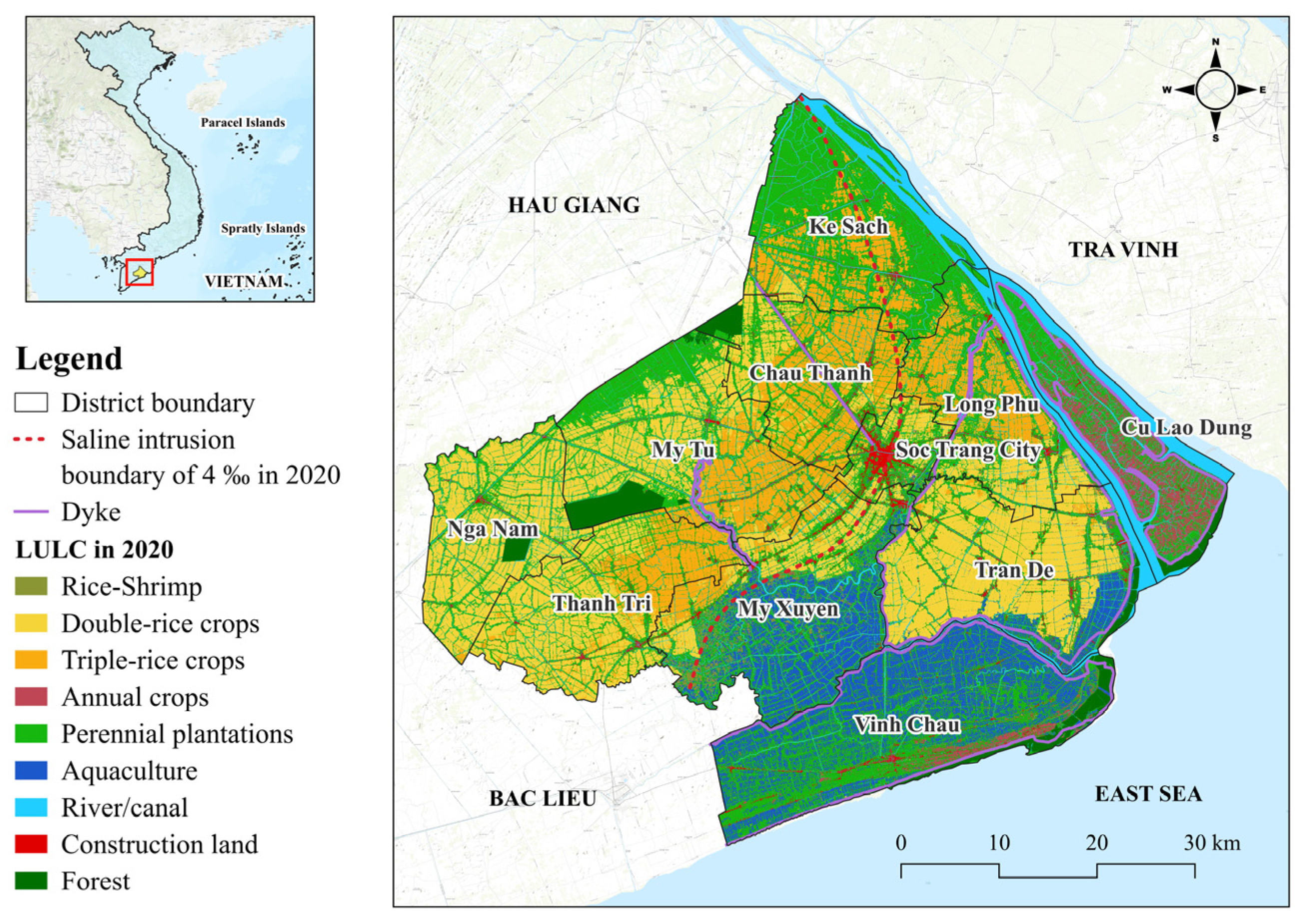
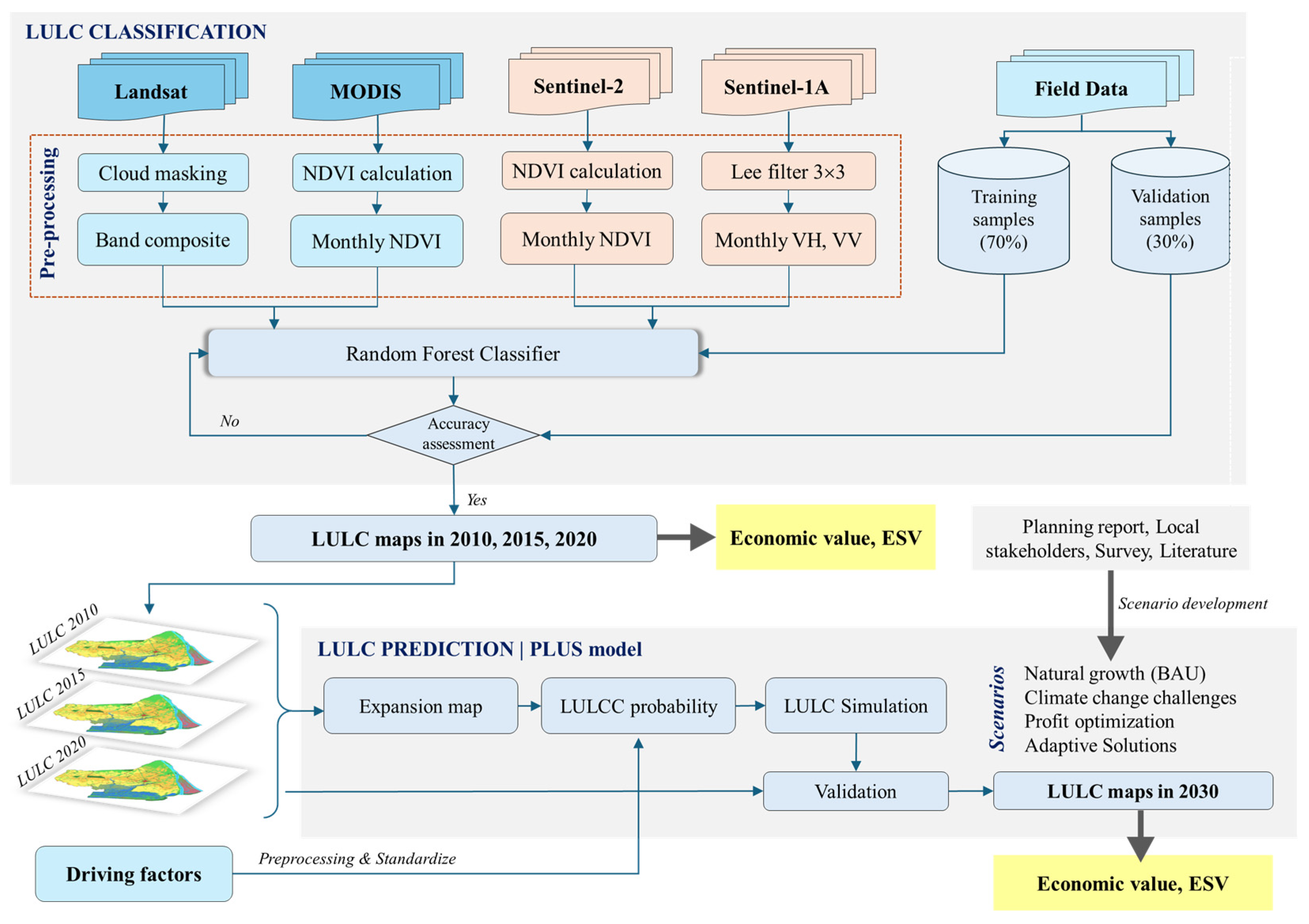
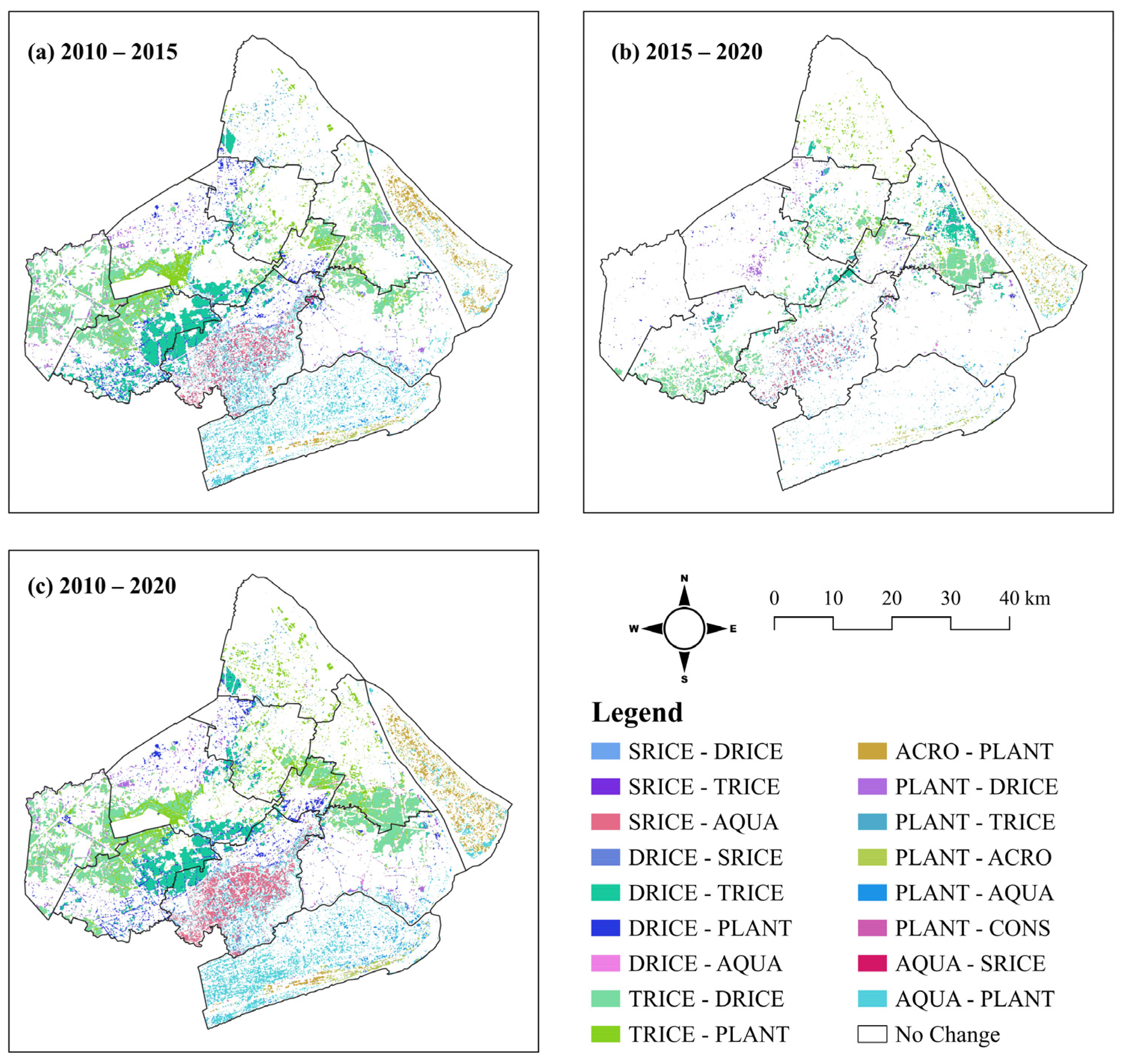
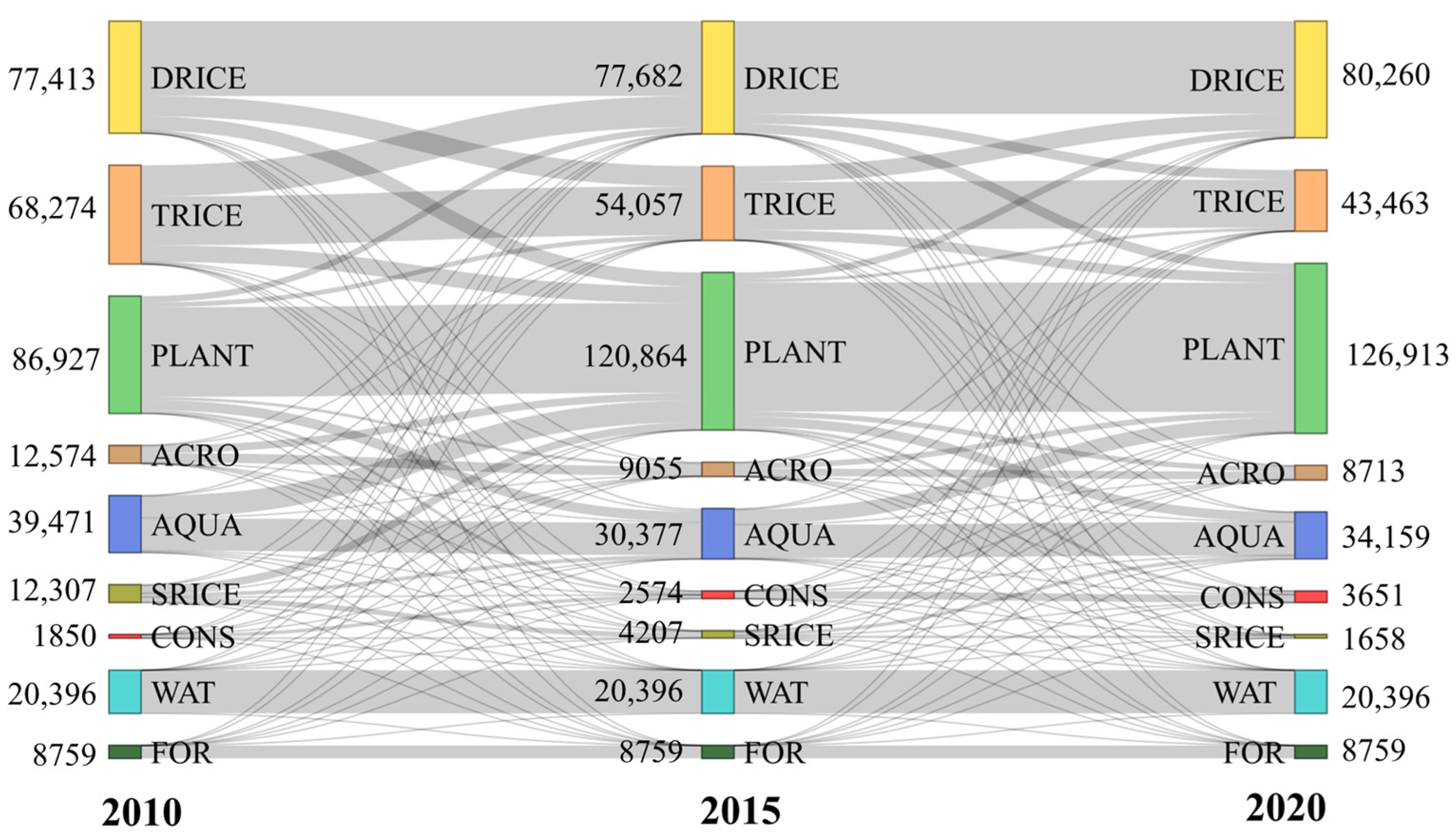
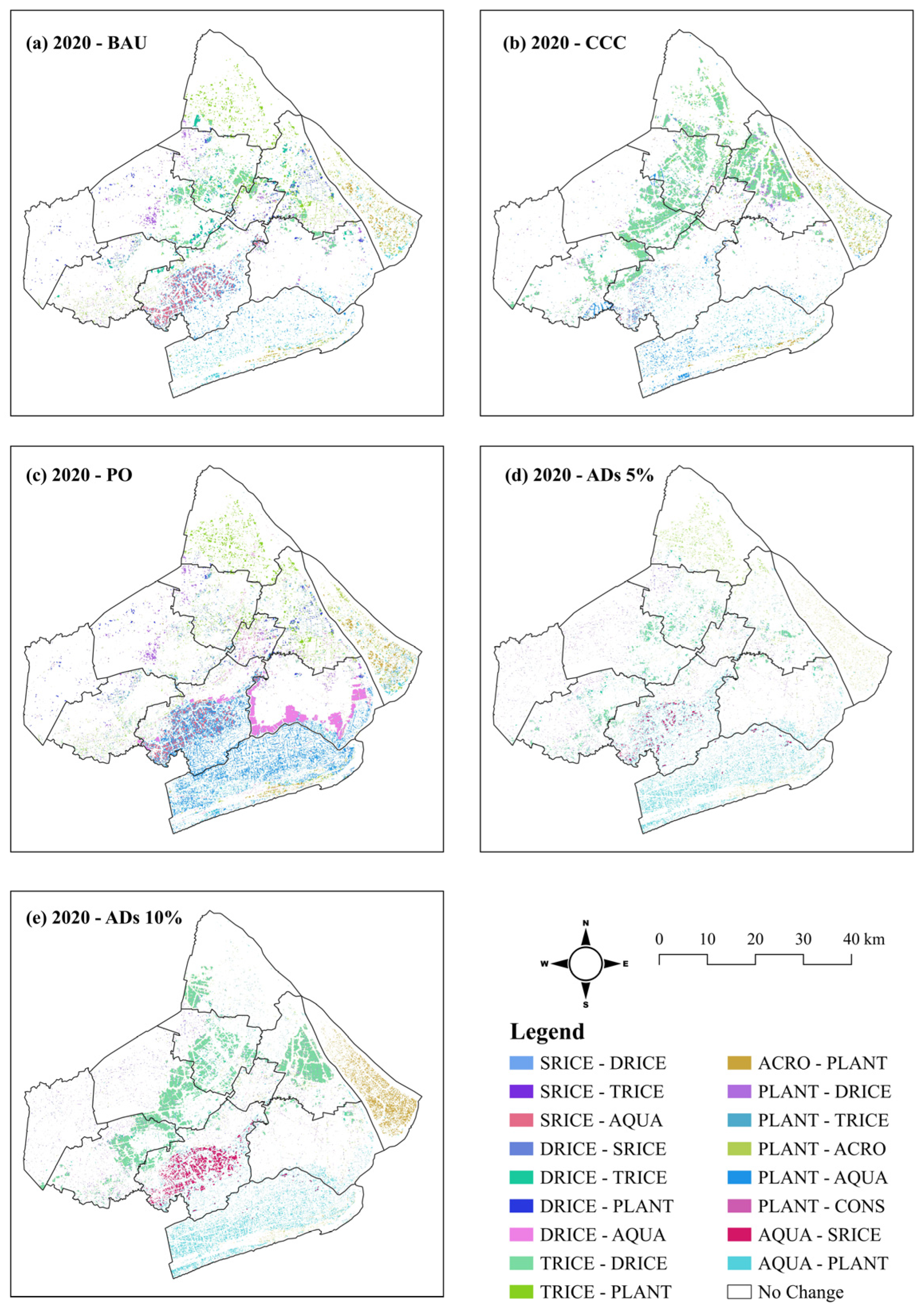
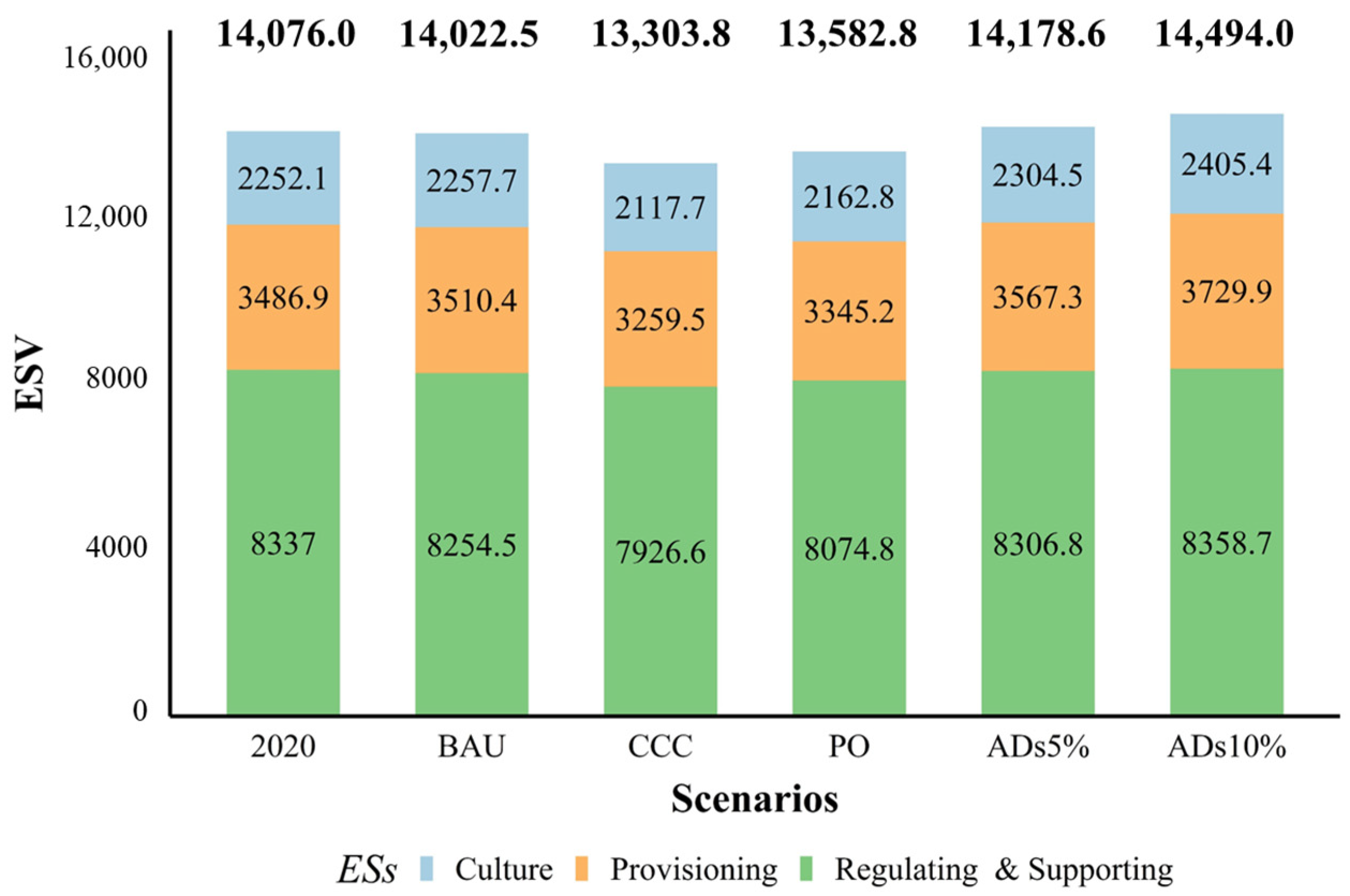

| Variable | Data Description | Data Sources |
|---|---|---|
| Socioeconomic factors | ||
| Population density | A one km resolution raster estimates the number of population distributions. Unit: persons/km2. | CIESIN |
| Distance to roads | Raster represents proximity to the main road network within the study areas. Unit: meter. | DNRE |
| Distance to urban areas | Raster of proximity to urban areas and centers extracted from land use maps. Unit: meter. | DNRE |
| Natural conditions | ||
| Annual mean temperature | Raster of average monthly temperature with approximate 30 arc-second resolution. Unit: °C. | WorldClim |
| Annual mean precipitation | Raster of average monthly precipitation with about 30 arc-second resolution. Unit: °C. | WorldClim |
| Soil type | Raster contains discrete ranking numbers corresponding to soil-type suitability for LULC categories. It is in discrete ranking units. | DNRE |
| Elevation | Raster data characterize terrain elevation extracted from DEM data with a pixel size of 30 meters. Unit: meter. | WorldClim |
| Slope | It describes terrain slopes derived from DEM data at 30-meter resolution. Unit: degrees. | Derived from DEM |
| Distance to river | Proximity raster data estimates the shortest distance to rivers, reflecting accessibility to water resources. Unit: meter. | DNRE |
| Distance to coastline | Shortest distance from any inland location to the coastal line. Unit: meter. | DNRE |
| Salinity | Raster data quantify salinity intrusion zones with corresponding salinity. Unit: grams/liter. | SIWR |
| Policy element | ||
| Distance to dikes | Raster data transformed from dike vector data to characterize proximity to dike systems. Unit: meter. | DARD |
| LULC Category | Description |
|---|---|
| Annual crops (ACRO) | Land cultivates crops that complete their life cycle within a single year, such as white radish, onion, sugarcane, maize, and other vegetables. |
| Aquaculture (AQUA) | Controlled water bodies and ponds are mainly distributed in brackish coastal areas, which are used for fishes, semi-intensive and intensive shrimp farming, and brine shrimp (Artemia). |
| Construction land (CONS) | Land occupied by residential areas, buildings, industrial zones, infrastructures, and other urban development purposes. |
| Forest (FOR) | Dense tree growth with natural and semi-natural ecosystems, such as natural reserves, plantation forests (Melaleuca), and mangroves. |
| Double rice crops (DRICE) | Agricultural land partly depends on rainwater, which grows two rice crops sequentially per year. |
| Triple rice crops (TRICE) | Agricultural land cultivates three high-yield and short-growing-period rice crops per year. It often requires intensive irrigation systems. |
| Rice–shrimp (SRICE) | A typical agricultural land use in coastal regions, where the land is alternately used for rice farming during rainy seasons and brackish shrimp farming in dry seasons. |
| Perennial plantations (PLANT) | Land is planted with long-lived crops and harvested over multiple years. It typically means orchards, such as mangosteen, durian, mango, pomelo, orange, tangerine, longan, guava, and star apple. |
| River/canal (WAT) | Natural water bodies (rivers and canals). |
| LULC | Economic Value | Provision | Regulating and Supporting | Culture | Total ESV |
|---|---|---|---|---|---|
| (USD/ha/Year) | (2020 US Dollars/ha/Year) | ||||
| SRICE | 1362.5 | 5694.0 | 17,262.4 | 3254.6 | 26,211.0 |
| DRICE | 3374.2 | 2814.0 | 16,827.3 | 824.3 | 20,465.6 |
| TRICE | 3813.3 | 4221.0 | 25,241.0 | 1236.4 | 30,698.4 |
| ACRO | 5737.5 | 1122.0 | 24,717.7 | 5779.0 | 31,618.7 |
| PLANT | 6954.5 | 20,344.0 | 30,464.3 | 12,989.6 | 63,798.0 |
| AQUA | 12,311.2 | 8574.0 | 17,697.5 | 5684.9 | 31,956.4 |
| WAT | - | 3883.7 | 40,882.3 | 5835.7 | 50,601.7 |
| CONS | - | 1455.5 | 11,413.0 | 240.0 | 13,108.5 |
| FOR | - | 11,310.0 | 34,134.7 | 12,989.6 | 58,434.3 |
| LULC | Area (ha) | Proportion (%) | AGR (%/Year) | ||||
|---|---|---|---|---|---|---|---|
| 2010 | 2015 | 2020 | 2010 | 2015 | 2020 | 2010–2020 | |
| SRICE | 12,307.2 | 4207.5 | 1658.7 | 3.73 | 1.28 | 0.50 | −8.65 |
| DRICE | 77,413.3 | 77,682.8 | 80,260.9 | 23.46 | 23.54 | 24.32 | 0.37 |
| TRICE | 68,274.7 | 54,057.6 | 43,463.5 | 20.69 | 16.38 | 13.17 | −3.63 |
| ACRO | 12,574.0 | 9055.7 | 8713.0 | 3.81 | 2.74 | 2.64 | −3.07 |
| PLANT | 86,927.8 | 120,864.2 | 126,913.0 | 26.34 | 36.63 | 38.46 | 4.60 |
| AQUA | 39,471.7 | 30,377.1 | 34,159.0 | 11.96 | 9.21 | 10.35 | −1.35 |
| WAT | 20,396.9 | 20,396.9 | 20,396.9 | 6.18 | 6.18 | 6.18 | - |
| CONS | 1850.8 | 2574.7 | 3651.5 | 0.56 | 0.78 | 1.11 | 9.73 |
| FOR | 8759.5 | 8759.5 | 8759.5 | 2.65 | 2.65 | 2.65 | - |
| LULC | Current Area (ha) | Predicted Area in 2030 (ha) | AGR (%/Year) | ||||||||
|---|---|---|---|---|---|---|---|---|---|---|---|
| 2020 | BAU | CCC | PO | ADs-5% | ADs-10% | BAU | CCC | PO | ADs-5% | ADs-10% | |
| SRICE | 1658.7 | 648.8 | 1064.4 | 1072.8 | 2315.8 | 6102.5 | −6.09 | −3.58 | −3.53 | 3.96 | 26.79 |
| DRICE | 80,260.9 | 90,255.7 | 106,047.2 | 76,361.7 | 98,396.4 | 103,799.3 | 1.25 | 3.21 | −0.49 | 2.26 | 2.93 |
| TRICE | 43,463.5 | 33,882.2 | 18,951.8 | 38,893.8 | 26,023.2 | 15,154.8 | −2.20 | −5.64 | −1.05 | −4.01 | −6.51 |
| ACRO | 8713.0 | 5935.7 | 8502.2 | 6394.0 | 8313.2 | 6293.1 | −3.19 | −0.24 | −2.66 | −0.46 | −2.78 |
| PLANT | 126,913.0 | 128,455.4 | 112,253.2 | 111,844.7 | 137,428.7 | 149,572.7 | 0.12 | −1.16 | −1.19 | 0.83 | 1.79 |
| AQUA | 34,159.0 | 35,643.2 | 46,062.7 | 56,986.6 | 20,452.3 | 11,910.5 | 0.43 | 3.48 | 6.68 | −4.01 | −6.51 |
| WAT | 20,396.9 | 20,396.9 | 20,396.9 | 20,396.9 | 20,396.9 | 20,396.9 | - | - | - | - | - |
| CONS | 3651.5 | 3998.6 | 5911.1 | 7266.0 | 5890.1 | 5986.7 | 0.95 | 6.19 | 9.90 | 6.13 | 6.40 |
| FOR | 8759.5 | 8759.5 | 8759.5 | 8759.5 | 8759.5 | 8759.5 | - | - | - | - | - |
| Total absolute area change (ha) | 26,737.0 | 79,926.1 | 52,884.4 | 63,093.7 | 105,954.0 | ||||||
Disclaimer/Publisher’s Note: The statements, opinions and data contained in all publications are solely those of the individual author(s) and contributor(s) and not of MDPI and/or the editor(s). MDPI and/or the editor(s) disclaim responsibility for any injury to people or property resulting from any ideas, methods, instructions or products referred to in the content. |
© 2025 by the authors. Licensee MDPI, Basel, Switzerland. This article is an open access article distributed under the terms and conditions of the Creative Commons Attribution (CC BY) license (https://creativecommons.org/licenses/by/4.0/).
Share and Cite
Diep, N.T.H.; Nguyen, N.T.; Diem, P.K.; Nguyen, C.T. Benefits and Trade-Offs from Land Use and Land Cover Changes Under Different Scenarios in the Coastal Delta of Vietnam. Land 2025, 14, 1063. https://doi.org/10.3390/land14051063
Diep NTH, Nguyen NT, Diem PK, Nguyen CT. Benefits and Trade-Offs from Land Use and Land Cover Changes Under Different Scenarios in the Coastal Delta of Vietnam. Land. 2025; 14(5):1063. https://doi.org/10.3390/land14051063
Chicago/Turabian StyleDiep, Nguyen Thi Hong, Nguyen Trong Nguyen, Phan Kieu Diem, and Can Trong Nguyen. 2025. "Benefits and Trade-Offs from Land Use and Land Cover Changes Under Different Scenarios in the Coastal Delta of Vietnam" Land 14, no. 5: 1063. https://doi.org/10.3390/land14051063
APA StyleDiep, N. T. H., Nguyen, N. T., Diem, P. K., & Nguyen, C. T. (2025). Benefits and Trade-Offs from Land Use and Land Cover Changes Under Different Scenarios in the Coastal Delta of Vietnam. Land, 14(5), 1063. https://doi.org/10.3390/land14051063








